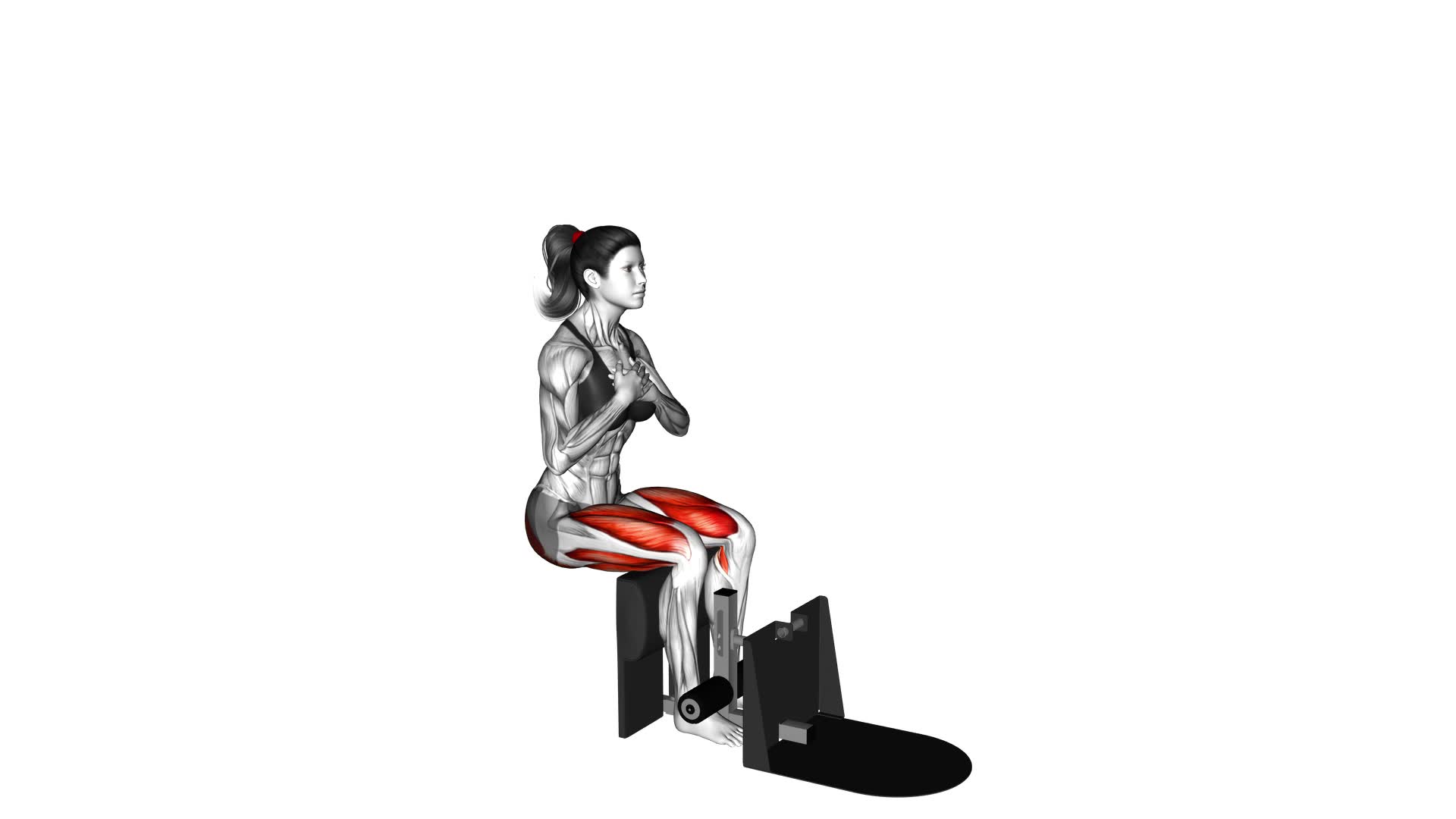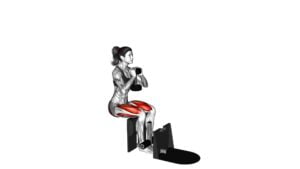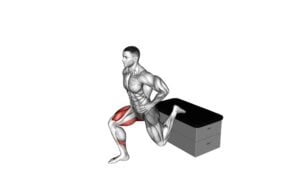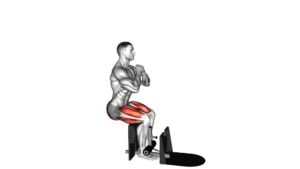Supported Squat (female) – Video Exercise Guide & Tips

Are you looking to strengthen your lower body and improve your squat technique? In this article, we've got you covered with a video exercise guide and helpful tips for supported squats.
Watch This Exercise Video
Discover the benefits of this exercise, learn the proper form, and find out which muscles you'll be targeting.
We'll also share common mistakes to avoid and ways to progress and vary your supported squats.
Get ready to maximize your workout with these expert tips!
Key Takeaways
- Supported squats strengthen the lower body and improve squatting technique.
- Proper form is crucial for optimal results and to engage the correct muscles while minimizing strain on joints.
- Common mistakes to avoid in supported squats include allowing knees to extend beyond toes and compromising knee stability and squat depth.
- Progression and variation in supported squats can enhance muscle activation, overall lower body strength, and stability.
Benefits of Supported Squats
Boost your fitness journey with the benefits of supported squats. Supported squats are a great exercise for beginners or those looking to improve their squatting technique. By using a chair or wall for support, you can focus on proper form and gradually progress to more challenging variations.
One of the key benefits of supported squats is the ability to learn and perfect the proper technique. By starting with a supported position, you can ensure that your knees are tracking correctly and your weight is distributed evenly. This is crucial for preventing injuries and maximizing the effectiveness of the exercise.
Another benefit of supported squats is the ability to gradually progress and increase the difficulty. As you become more comfortable and confident with the movement, you can gradually decrease the amount of support you rely on. This progression technique allows you to challenge your muscles and continue to make progress in your fitness journey.
Proper breathing technique is also emphasized during supported squats. By inhaling deeply before lowering down and exhaling forcefully as you rise back up, you can engage your core muscles and maintain stability throughout the movement.
Proper Form for Supported Squats
Mastering the proper form for supported squats is essential for achieving optimal results and preventing injuries. Proper form not only maximizes the effectiveness of the exercise but also ensures that you're engaging the correct muscles and minimizing strain on your joints.
One of the key benefits of maintaining proper form during supported squats is that it helps to build strength in your lower body. By keeping your feet shoulder-width apart and your knees aligned with your toes, you engage your quadriceps, hamstrings, and glutes more effectively. This leads to increased muscle activation and development.
Additionally, proper form during supported squats helps to improve your overall balance and stability. By keeping your torso upright and your core engaged, you enhance your proprioception, which is your body's ability to sense its position in space. This can be especially beneficial for beginners who may struggle with balance initially.
For beginners, there are several variations of supported squats that can help ease into the exercise. One option is to perform the squats with a chair behind you, allowing you to lower yourself down and lightly tap the chair before standing back up. This provides additional support and reduces the range of motion initially.
Muscles Targeted in Supported Squats
To maximize the effectiveness of supported squats and prevent injuries, it's important to understand the specific muscles that are targeted during this exercise. Supported squats primarily work the muscles in your lower body, including your quadriceps, hamstrings, glutes, and calves. These muscles are responsible for powering your movements and providing stability during the exercise.
The quadriceps, located in the front of your thighs, are heavily engaged during supported squats. They help to extend your knees and straighten your legs as you rise from the squatting position. The hamstrings, located in the back of your thighs, work in conjunction with the quadriceps to control your movement and provide balance.
Your glutes, or buttocks muscles, are also targeted during supported squats. They help to stabilize your hips and provide power when you push yourself back to a standing position. Additionally, the calves play a role in supporting and stabilizing your ankles throughout the exercise.
Supported squats can be performed with various modifications and variations to target specific muscles. For example, you can use dumbbells or a barbell to increase the intensity and target your quadriceps and glutes more effectively. Alternatively, you can try widening or narrowing your stance to shift the focus to different muscle groups.
Understanding the muscles worked in supported squats and exploring variations can help you tailor your workouts to meet your specific goals and needs. Remember to always maintain proper form and consult a professional if you have any concerns or questions.
Common Mistakes to Avoid in Supported Squats
When performing supported squats, it's important to avoid common mistakes that can hinder your progress and increase the risk of injury.
One common mistake to avoid is letting your knees extend beyond your toes during the squat. This can put excessive strain on your knees and lead to discomfort or injury.
Another mistake to avoid is improper hip alignment, as this can put unnecessary stress on your lower back.
Lastly, remember to engage your core muscles throughout the exercise to maintain stability and support your spine.
Knee Over Toe Technique
Avoid making the common mistake of allowing your knees to go over your toes when performing supported squats. This mistake can compromise knee stability and decrease squat depth. To ensure proper form and prevent injury, keep the following tips in mind:
- Maintain proper alignment: Keep your knees in line with your toes throughout the entire movement. This will help distribute the load evenly and maintain stability.
- Engage your glutes and core: Activating these muscles will help support your knees and prevent them from moving too far forward.
- Focus on hip hinge: Initiate the squat by pushing your hips back, rather than allowing your knees to lead the movement. This will help maintain a more upright posture and prevent your knees from going over your toes.
Proper Hip Alignment
Maintain proper hip alignment throughout the supported squats to avoid common mistakes and maximize the effectiveness of the exercise. Proper hip alignment is crucial for both hip mobility and hip strengthening.
When performing supported squats, it's important to ensure that your hips are properly aligned. One common mistake to avoid is allowing your hips to shift forward or backward during the movement. This can put unnecessary strain on your lower back and reduce the activation of your glute muscles.
To maintain proper hip alignment, focus on keeping your hips in line with your knees and ankles throughout the entire squat motion. Engage your core and keep your chest lifted to support your hip alignment.
Engaging Core Muscles
To effectively engage your core muscles during supported squats, it's crucial that you focus on maintaining proper hip alignment throughout the exercise. This won't only help you build strength in your core, but also prevent any unnecessary strain on your lower back.
Here are some common mistakes to avoid when engaging your core muscles in supported squats:
- Not bracing your core: Remember to keep your abdominal muscles tight throughout the movement. This will provide stability and support to your spine.
- Arching your back: Avoid overarching your lower back, as it can lead to excessive pressure on your spine. Instead, maintain a neutral spine position throughout the exercise.
Progression and Variation of Supported Squats
Now that you have mastered the basic supported squat, it's time to explore different squat modifications to challenge and progress your workout.
By incorporating variations such as goblet squats, sumo squats, or Bulgarian split squats, you can target different muscle groups and continue to build strength and stability.
The benefits of progression in supported squats include increased muscle activation, improved balance, and enhanced overall lower body strength.
Different Squat Modifications
Try incorporating different squat modifications to progress and vary your supported squat exercises. By adding these variations to your routine, you can target different muscle groups and enhance your overall strength and stability.
Here are two different modifications you can try:
- Sumo Squat: Take a wider stance with your toes pointed slightly outward. This variation places more emphasis on the inner thighs and glutes, helping to build strength in those areas.
- Bulgarian Split Squat: Stand in a split stance with one foot elevated behind you on a bench or step. This modification challenges your balance and stability while targeting the quads and glutes.
Benefits of different squat variations include improved muscle activation, increased range of motion, and the ability to target specific areas of the lower body. Incorporating these modifications into your routine can help prevent plateaus and keep your workouts challenging and effective.
Benefits of Progression
Improve your strength and stability by incorporating progression and variation into your supported squat exercises.
Progression tips, variations, and modifications can help you continually challenge your muscles and prevent stagnation in your workouts. Gradually increasing the difficulty of your supported squats by adding weight, increasing repetitions, or decreasing rest time can help you build strength and endurance over time.
You can also try different variations of supported squats, such as wide stance squats, sumo squats, or pistol squats, to target different muscle groups and add variety to your routine.
Additionally, modifying your squat depth, using different equipment like resistance bands or stability balls, or incorporating plyometric movements can further enhance the benefits of your supported squats.
Remember to consult with a fitness professional for personalized progression tips and to ensure proper form and technique.
Tips for Getting the Most Out of Supported Squats
To maximize your results with supported squats, focus on maintaining proper form throughout the exercise. This won't only ensure that you target the right muscles but also help prevent any injuries.
Here are some tips to help you get the most out of your supported squats:
- Engaging glute muscles:
- As you lower into the squat, focus on squeezing your glute muscles. This will help activate and strengthen them.
- Make sure to keep your weight evenly distributed between your heels and the balls of your feet. This will help you engage your glutes more effectively.
- Breathing techniques:
- Inhale as you lower down into the squat. This will help you maintain stability and control your movement.
- Exhale as you push back up to the starting position. This will help you generate power and maintain proper form.
Frequently Asked Questions
How Many Sets and Reps Should I Do When Performing Supported Squats?
When performing supported squats, it's important to consider the number of sets and reps that best suit your fitness level and goals. To determine this, you can start with 2-3 sets of 10-12 reps and adjust as needed.
Remember, supported squats are a great exercise for building lower body strength and stability.
If you're looking for alternative exercises, lunges and step-ups are also effective options.
Just make sure to maintain proper form throughout your workouts to maximize the benefits and minimize the risk of injury.
Can Supported Squats Help Improve My Balance and Stability?
Supported squats can be a valuable exercise for improving your balance and stability. By providing support, this exercise allows you to focus on maintaining proper form and alignment.
To enhance your balance during supported squats, engage your core, keep your feet firmly planted on the ground, and distribute your weight evenly.
Remember to start with a weight that's manageable for you and gradually increase as you become more comfortable and confident.
Is It Necessary to Use a Support or Can I Perform Supported Squats Without One?
Using a support during squats has its benefits. It can provide stability and help you maintain proper form. Without a support, performing supported squats may be challenging. However, with the right technique, you can still perform supported squats without one.
To properly use a support during squats, make sure it's at a height that allows you to comfortably lower your body. This will help you engage your muscles effectively and reduce the risk of injury.
Are There Any Modifications or Alternatives for People With Knee or Back Issues?
If you have knee or back issues, there are modifications and alternatives to supported squats that you can try. These modifications can help reduce stress on your knees and back while still targeting the same muscle groups.
Some options include using a stability ball against a wall for support, performing wall squats, or using a chair for assistance.
Supported squats are beneficial for rehabilitation as they help improve lower body strength and stability.
Can Supported Squats Be Beneficial for Weight Loss and Toning the Lower Body?
Supported squats can be effective for building muscle and toning the lower body. By providing support, they reduce strain on the knees and back, making them suitable for those with knee or back issues.
Additionally, supported squats can be incorporated into a full body workout routine to target multiple muscle groups. Including them in your routine can help with weight loss and overall body toning.
Make sure to maintain proper form and gradually increase the difficulty as you progress.
Conclusion
In conclusion, supported squats are an effective exercise for women that provide numerous benefits, including increased leg and core strength.
By maintaining proper form and avoiding common mistakes, individuals can maximize the effectiveness of this exercise.
Additionally, progressing and varying the supported squats can help challenge the muscles in new ways.
By following these tips and guidelines, women can get the most out of their supported squat workouts.

Author
Years ago, the spark of my life’s passion ignited in my mind the moment I stepped into the local gym for the first time. The inaugural bead of perspiration, the initial endeavor, the very first surge of endorphins, and a sense of pride that washed over me post-workout marked the beginning of my deep-seated interest in strength sports, fitness, and sports nutrition. This very curiosity blossomed rapidly into a profound fascination, propelling me to earn a Master’s degree in Physical Education from the Academy of Physical Education in Krakow, followed by a Sports Manager diploma from the Jagiellonian University. My journey of growth led me to gain more specialized qualifications, such as being a certified personal trainer with a focus on sports dietetics, a lifeguard, and an instructor for wellness and corrective gymnastics. Theoretical knowledge paired seamlessly with practical experience, reinforcing my belief that the transformation of individuals under my guidance was also a reflection of my personal growth. This belief holds true even today. Each day, I strive to push the boundaries and explore new realms. These realms gently elevate me to greater heights. The unique combination of passion for my field and the continuous quest for growth fuels my drive to break new ground.



